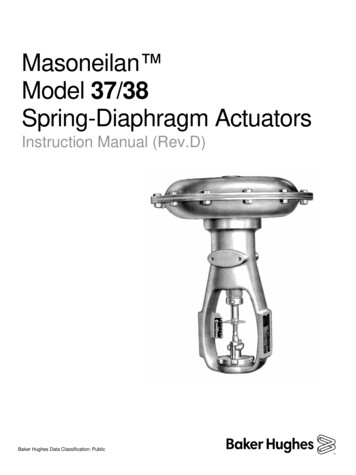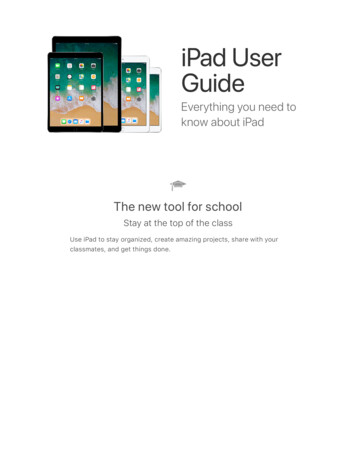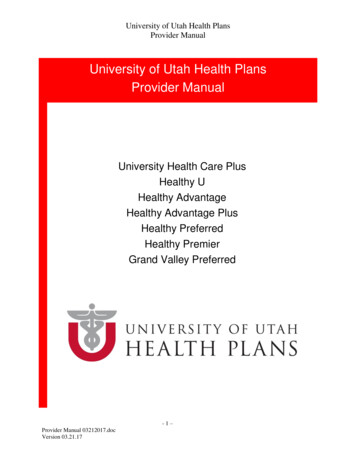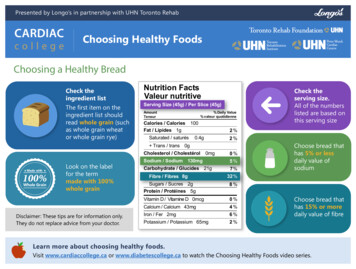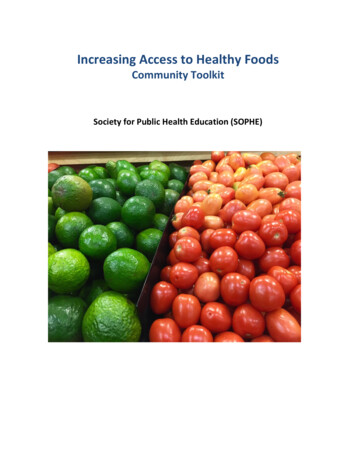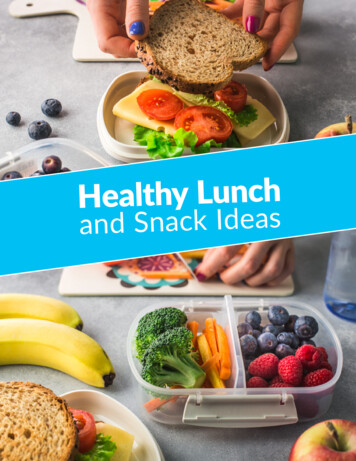
Transcription
Healthy Lunchand Snack Ideas
saedIkcanSdnahcnuLyhtlaeHStudies show that well-nourished children can concentrate longer and perform better at school.Include healthy foods and drinks in school lunches to make sure children are ready to learn.Tips for packing a healthy and safe school lunch: Plan ahead;Get the children involved;Use leftovers to save time;Use a thermos to help keep hot foods hot. Warm the thermos with boiling water before filling itwith hot food;Use an insulated lunch bag and a freezer pack to keep cold foods cold;Wash fresh vegetables and fruits;Not all food that comes home in the lunch bag can be reused. Leftover sandwiches,hot foods, milk, yogurt and cheese are not safe to eat another day so don't repack those foods.Also do not reuse wrappings;Wash reusable beverage and food containers with soap and hot water;Teach children to wash their hands before eating.ALLERGYALERTAllergy Alert! Some healthy food and beveragechoices are not permitted at school due to allergyawareness. Several schools are peanut aware orhave policies around other foods so check withyour school about these foods and avoid packingthem for lunch and snacks.Healthy Lunch and Snack Ideas1
Use Canada’s Food Guide to pack tasty,healthy choices for growing bodiesFor a well-balanced lunch, include foods from all groupings of the Canada’s Food GuideEat protein foodsHave plentyof vegetablesand fruitsMake wateryour drinkof choiceChoose whole grain foods2Healthy Lunch and Snack Ideas
Vegetables and fruitsProtein foodsVegetables and fruits are important for growthand development. They provide a variety ofvitamins, minerals and fibre, and contribute tooverall well-being. To help children get enoughvegetables and fruits, include them with everymeal and snack.Choose plant-based protein foods like hummusor beans, which are healthy, full of fibre and canbe more affordable. Hard-boiled eggs, cheeseand left over lean meat, chicken or turkey arealso great options for packed lunches.Whole grain foodsMake sure you include whole grain foods, whichare key to getting enough fibre and vitamins.You can use whole grain breads, rolls or wrapsfor sandwiches and whole grain crackers orcereal for grab-and-go choices.Healthy lunch ideas Thermos of chili with a whole grain roll andan orange; Mini pizza (made with a whole grain Englishmuffin, sauce, veggies such as tomatoesand peppers and topped with cheese) andcanned peaches; Homemade chicken and vegetable soup,whole grain crackers and an apple; Turkey sandwich on whole grain breadwith lettuce and tomato, yogurt and frozenblueberries.Healthy Lunch and Snack Ideas3
Make water the drink of choice and send it to school in a reusable bottle. Other healthy drinkoptions include white milk or unsweetened fortified plant-based beverages such as soy or almondbeverage.Limit sugary drinks such as soft drinks, fruit-flavored drinks, 100% fruit juice, flavoured waters withadded sugars, vitamin waters, sport and energy drinks, hot chocolate, iced tea and other sweetenedhot or cold beverages. Children also do not need food or drinks with artificial sweeteners.Make your own “lunch kits ”Kids often want packaged foods they see on TV, online, or in their friends’ lunches. Be aware offoods marketed to kids and ongoing new products on the shelf. Store bought lunch kits can be highin sodium (salt), sugars and/or saturated fat and are usually low in fibre and other nutrients.Try a reusable container with sections to make your own lunch kits. Kids like finger foods,so cut sandwiches, wraps or other foods into smaller pieces. Add raw veggies or fruits to completethe kit.Don’t forget snacks!To get the variety of nutrients children need for growth and development, as well as for lifelonghealthy bodies, include at least one healthy snack each day in your child’s lunch bag.Healthy snack ideas 4Apple slices and cheese;Yogurt and canned fruit;Carrot and turnip strips with hummus for dip;Fruit salad made with fresh, frozen or canned fruits;Whole grain cereal with white milk and fresh or frozen berries;Homemade muffin and a banana;Hard-boiled egg and an orange.Healthy Lunch and Snack Ideas
Limit the amount of highly processed foods you offer for lunches and snacks. Examples ofprocessed foods include: sugary drinks;chocolate and candies;ice cream and frozen desserts;fast foods like French fries and burgers;frozen packaged meals like pasta dishes and pizzas;bakery products like muffins, buns and cakes;processed meats like sausages, bologna, wieners, and deli meats;fruit leathers and other types of fruit snacks with added sugar;chips and cheesies.These foods can be high in sodium (salt), sugars and/or saturated fat. If you choose to include thesehighly processed foods, do so less often and send small amounts. It is what a child eats over timethat matters most, not what they eat occasionally. Try to pack healthy choices most often.Label reading: Use the Nutrition Facts Table on store-bought products to help you choose thehealthiest options. Using the percent Daily Value (% DV) can help you choose products that arelower in sodium, sugars and saturated fats. Anything with 5% DV or less is considered "a little” ofthat particular nutrient, while anything with 15% DV or more is considered “a lot”.Check the list of ingredients as well; a food contains more of the ingredients found at thebeginning of the list, and less of the ingredients at the end of the list.Did you know? Children usually have about 20 minutes to eat lunch at school. For youngerchildren, save time by peeling fruit when possible and cut up foods into smaller pieces, beforepacking in their lunch bags.Healthy Lunch and Snack Ideas5
Healthy Eatingfor Everyone2020
Include healthy foods and drinks in school lunches to make sure children are ready to learn. . Limit sugary drinks such as soft drinks, fruit-flavored drinks, 100% fruit juice, flavoured waters with added sugars, vitamin waters, sport and energy drinks, hot chocolate, iced tea and other sweetened . healthiest options. Using the percent .




